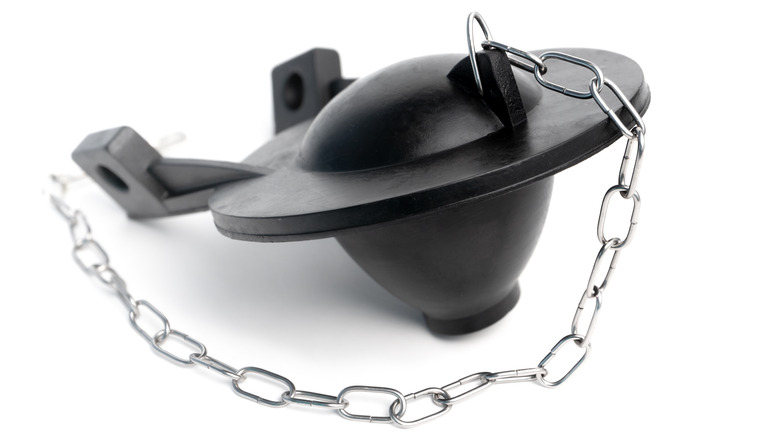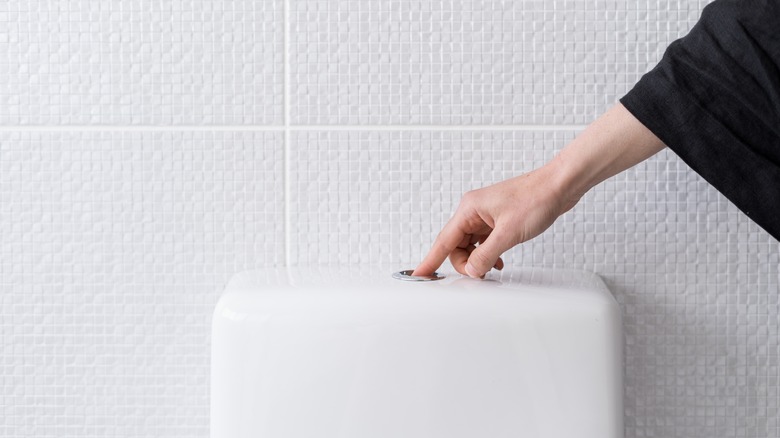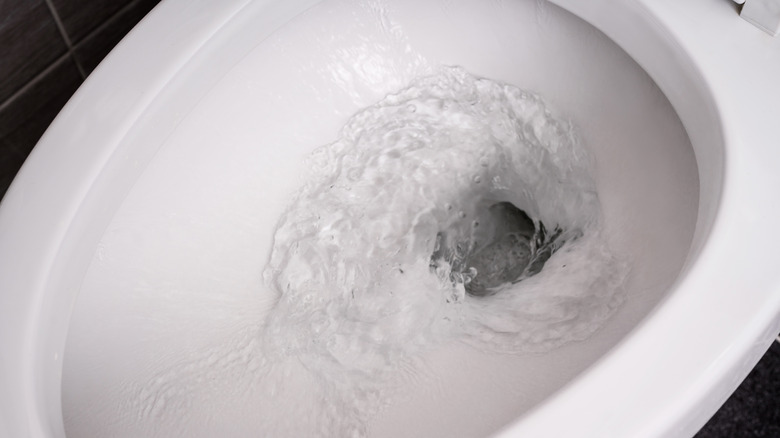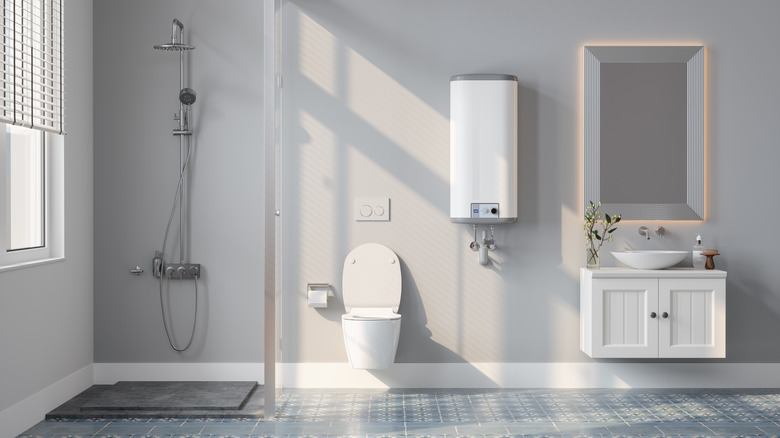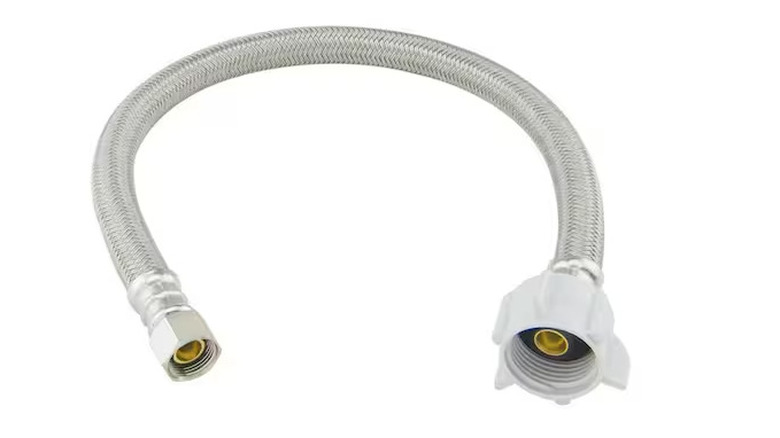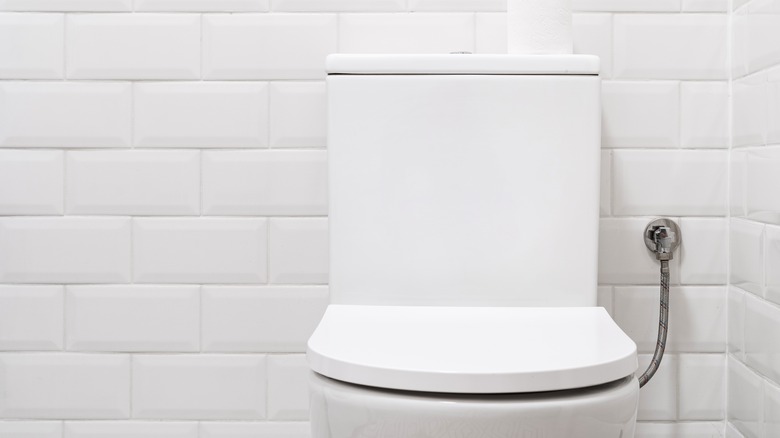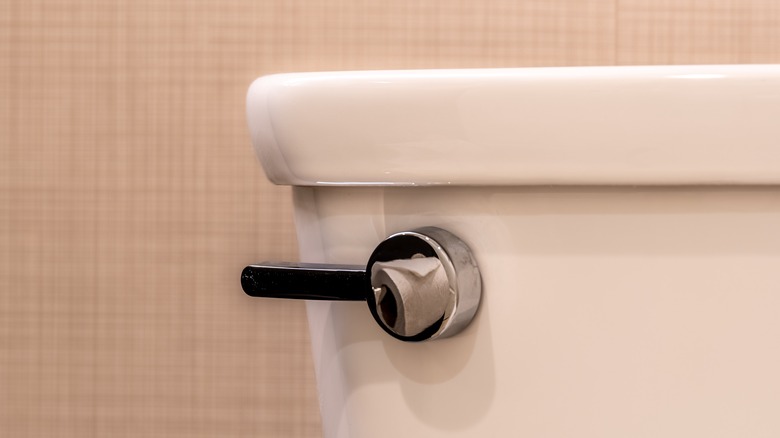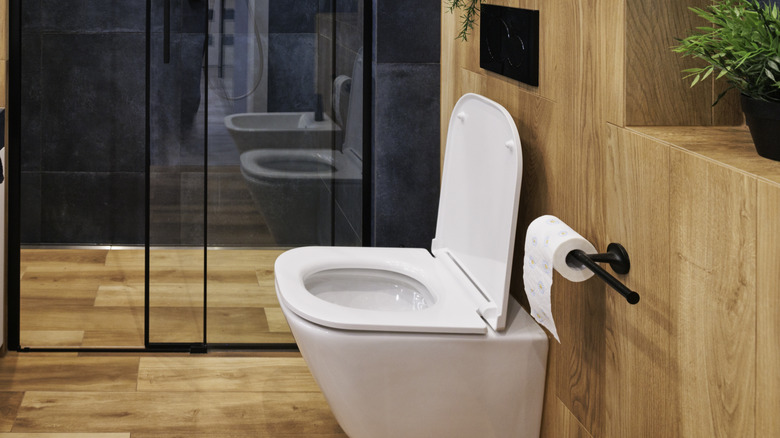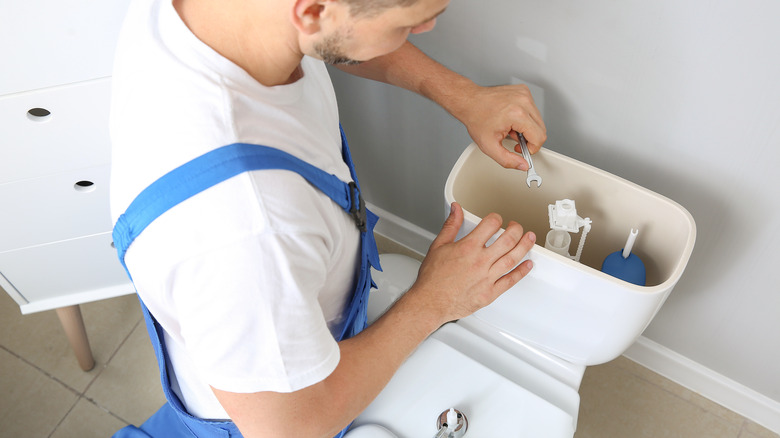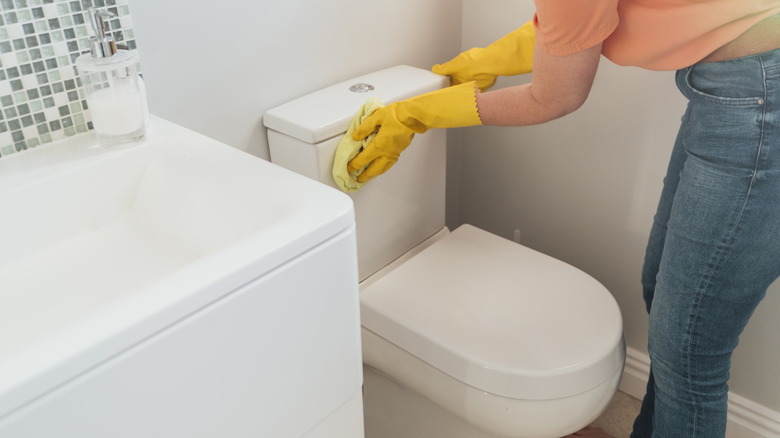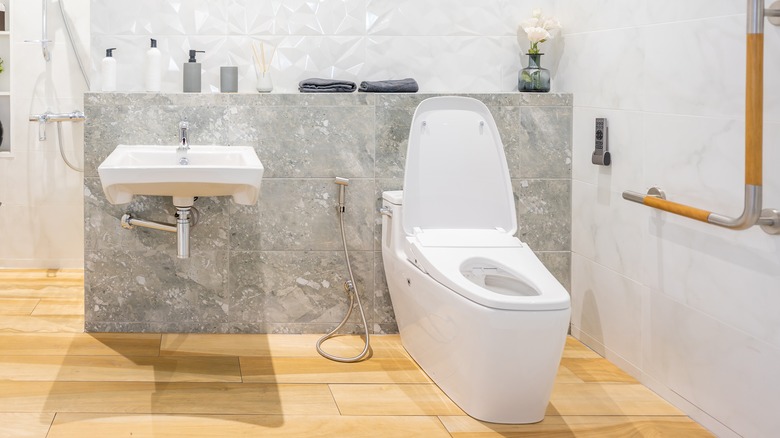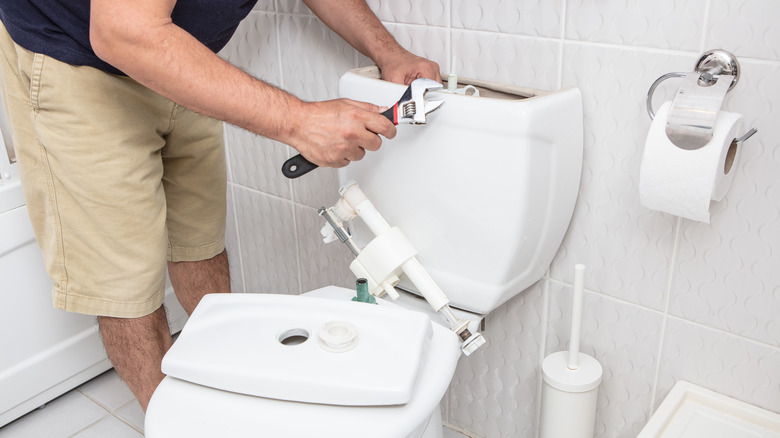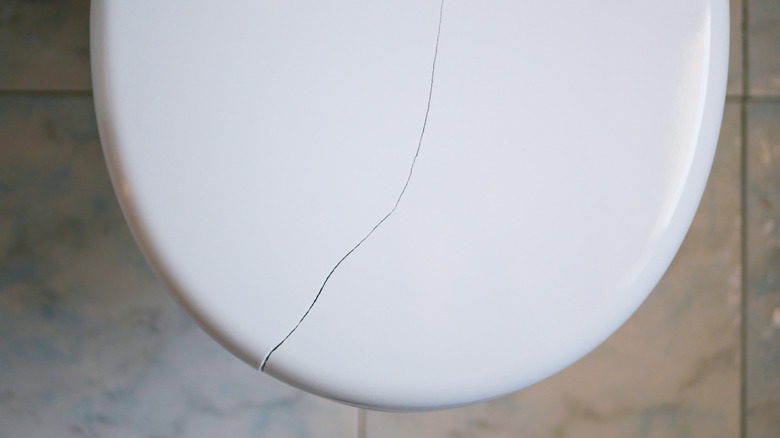Common Toilet Problems You Shouldn't Turn A Blind Eye To
Performing any sort of maintenance on our toilets can sometimes seem overwhelming. After all, it's a human waste receptacle, which might be a little icky to some. Plus, tackling plumbing issues requires a certain level of skill. However, ignoring common toilet problems can lead to even bigger issues down the line. If you turn a blind eye to little things, you might find yourself with high water bills, a cracked toilet seat, and wastewater filling up your living room — not a great situation to be in.
Whether the issue is a leaky supply line, a weak or phantom flush, or even a broken toilet handle, taking the time to understand the underlying causes and implementing the necessary repairs or replacements can save you from future headaches and expenses. Whether you are just renting or taking care of your own home, being proactive and addressing these common toilet issues can ensure you have a well-functioning plumbing system in your home.
Continuously running toliet water
A toilet that keeps running after you flush is a noisy and expensive problem. The most common cause of this issue is a faulty flapper valve or a flapper that doesn't seal properly. When this happens, the water continuously flows from the tank into the bowl because there is nothing to hold it back. Another possible cause could be a malfunctioning fill valve that fails to properly shut off the water supply. Sometimes, you might get lucky and find that the issue is just that the lift wire has shifted down a few notches.
To fix continuous running water, start by inspecting the flapper for any signs of damage, debris, or misalignment. Clean or replace the flapper if necessary, ensuring it forms a watertight seal when closed. If the fill valve is causing the problem, adjust or replace it to stop the water flow at the desired level. If it's the lift wire, you just have to take the lid off the tank and pull the wire back up into place. Once finished, you should also check the tank's water level and ensure it reaches the designated fill line and stops shortly after.
A weak flush
Experiencing a weak flush in a toilet can be frustrating and inconvenient. Unfortunately, there are several different reasons the flush might be weak, so it might take a bit to diagnose the issue. One common cause is a partial clog in the drain of the toilet. Accumulated debris, like toilet paper, feminine hygiene products, or even "flushable wipes" (they usually aren't!), can restrict the water flow, resulting in a weak flush. Another possible cause is a problem with the water level in the tank. If the water level is too low, it may not provide enough force for an effective flush.
To fix a weak flush, start by using a plunger to try and clear any clogs in the drain. Ensure a tight seal between the plunger and the drain opening, and use a vigorous up-and-down motion to create suction and dislodge the blockage. If that doesn't work, you might need to use a toilet auger (sometimes called a snake) for more serious clogs. If the water level is low in the tank, adjust the fill valve or the float to increase the water level. This will provide more water for a stronger flush.
Phantom flushing
Phantom flushing is sometimes also called ghost flushing. It's a common issue in toilets when the tank refills itself as if it were being flushed, even when nobody has used the facilities. This can lead to a lot of wasted water and increased water bills. The most common cause of phantom flushing is a faulty flapper valve, which is responsible for sealing the tank and preventing water from flowing into the bowl. When the flapper is worn out or improperly aligned, water slowly leaks from the tank into the bowl, triggering the refill mechanism.
To fix phantom flushing, start by inspecting the flapper valve on your toilet for any signs of damage or misalignment. This can be caused by mold or decay. If necessary, replace the flapper with a new one that fits your toilet model. You can purchase them at most hardware stores. Additionally, check the chain or lift wire connecting the flapper to the flush handle to see if it has the correct tension. Adjust it if needed, allowing the flapper to fully close after each flush. This should be enough to fix phantom flushing without making a call to Ghostbusters.
An overflowing toilet
The most common reason for an overflowing toilet is a clog. If you flush and the water starts rising, that's the issue. However, sometimes there are less obvious reasons that cause this panic-inducing situation. There could be a malfunctioning flapper or fill valve, or sometimes excessive water pressure caused by work elsewhere in the house.
To fix an overflowing toilet, start by shutting off the water supply valve near the toilet's base. This will stop the water flow and prevent further spillage. Once the immediate threat is over, it's time to check the flapper and fill valve. Sometimes the flapper is worn out or doesn't close all the way, which means more water is pushing through than necessary. If it's the fill valve, check the position of the float. If it's stuck, that's typically the issue. Once you've made these two adjustments, turn on the water supply valve and allow the tank to fill. Observe the flushing process to ensure the water stops filling at the appropriate level and does not overflow.
Leaky supply line
Dealing with a leaky supply line in a toilet can lead to severe water damage to your home, particularly the flooring. The supply line is the flexible hose that connects the water supply valve to the toilet tank. If it develops a leak, you will likely notice water pooling around the toilet's base. The leak is typically caused by a loose connection (by age or poor installation), damaged or worn-out washers, or a cracked supply line. This might happen during cleaning, although it's more likely to accidentally occur during home renovations.
To fix a leaky supply line, start by turning off the water supply valve near the toilet's base. Use a wrench to ensure tight connections at both ends of the supply line. If the leak persists, carefully remove the supply line and inspect the washers for chips or cracks. Replace any damaged or worn-out washers and reassemble the supply line, ensuring a tight connection. If the line itself is cracked or damaged, it's best to replace it entirely. Choose a new one of the appropriate length and ensure it is compatible with your toilet specifically. Once installed, turn on the water supply valve and check for leaks. To make sure things are working properly, flush the toilet a few times, then check again.
Leaking water tank
One possibility for a leaking toilet tank is a faulty or worn-out tank-to-bowl gasket. This gasket creates a watertight seal between the tank and the bowl. If it deteriorates or becomes misaligned, water can leak out. Another cause could be cracks or damage in the tank itself, which can occur over time due to hard use or damage during renovations.
To fix a leaky tank, start by turning off the water supply valve and flushing the toilet several times to empty the tank. Inspect the tank-to-bowl gasket for any signs of wear or misalignment. If necessary, replace the gasket with a new one that matches your toilet model. If the tank has visible cracks, it may need to be replaced entirely. If this is the case, we recommend consulting a professional plumber who can safely remove the old tank and install a new one. Unless you are a DIY master, this can be tough to do on your own. After completing the repairs, turn on the water supply valve, allow the tank to fill, and check for any leaks.
Weak or broken flush handle
If the flush handle feels loose or doesn't properly activate the flush mechanism, it may need adjustment or replacement. This can be an annoying problem, as it leaves you open to potential embarrassment. The handle is connected to a chain that lifts the flapper or flush valve, allowing water to flow from the tank into the bowl. Over time, the handle may become loose, corroded, or broken, resulting in a weak or non-functional flush.
To fix the problem, remove the tank lid and examine the handle mechanism. Tighten any loose screws or connections to ensure a secure fit. If the handle is broken, you may need to replace it with a new one. To do this, disconnect the lift chain or lift wire from the old handle and attach it to the new handle, ensuring proper alignment and tension. Test the flush by pressing the new handle to ensure it lifts the flapper or flush valve effectively. If the problem persists, it's best to speak with a plumber so you aren't stuck with a toilet that won't flush.
Toilet rocking back and forth
Using a wobbly or rocking toilet can be an uncomfortable experience. If this happens, don't be embarrassed, as a loose toilet has nothing to do with the person using it. Instead, when the toilet flange is not level or securely attached to the floor, it can lead to rocking and instability. Other reasons are if the anchor bolts that secure the toilet to the flange are loose or damaged, or if there is a worn-out or compressed wax ring between the toilet and the flange.
Fixing a rocking toilet is more involved than other plumbing work. If you are not confident in your skills, it's best to bring in a plumber. If you do go the DIY route, start by turning off the water supply. First, check the anchor bolts and tighten them if they are loose or replace them if they are damaged. Sometimes they can be cracked or rusted, so fixing them may remedy the problem. If not, you may have to remove the toilet to check the flange. This is the part that connects the toilet to the drain pipe. Take a look to see if it is level, securely fastened, and in good condition. If necessary, repair or replace the flange. Finally, replace the wax ring with a new one and reinstall the toilet, ensuring it sits securely and evenly on the flange. After reconnecting the water supply, test the toilet to ensure it no longer rocks or wobbles.
Water tank that refills slowly
A slow-refilling toilet tank can be a frustrating issue that can disrupt the normal functioning of the toilet. Older toilets can sometimes take longer to fill up, but the tank should still be completely filled within a few minutes. If it's taking longer, it might be because of a faulty fill valve, a partially closed supply valve, or sediment buildup in the fill valve or supply line.
To fix a slow-refilling toilet tank, start by checking the supply valve to ensure it is fully open. If it's partially closed, turn it counterclockwise to open it completely. Next, inspect the fill valve for any signs of damage or malfunction. Clean the fill valve and supply line to remove any sediment or debris obstructing water flow. If the fill valve is faulty, consider replacing it with a new one.
Additionally, check for any kinks or blockages in the supply line and ensure it is properly connected. Once you're finished, you can turn the water supply valve back on and monitor the refill process. It should fill up quickly.
Hard water deposits
Hard water stains are a common and unsightly problem in toilets. They are caused by the mineral deposits left behind when water evaporates. The primary culprit behind hard water stains is the presence of high levels of minerals like calcium and magnesium in the water supply. While these blotches are not harmful to health, they can be unsightly and difficult to remove. They can be particularly unappealing on toilets as guests might associate them with your home being unclean.
To fix hard water stains, start by using household remedies like vinegar or lemon juice. These acidic substances can dissolve the mineral deposits. Apply them to the stained areas, let them sit for a while, and then scrub gently with a toilet brush. For tougher stains, you can use commercial descaling products specifically designed to remove hard water residue. It's also important to consider long-term prevention by using water conditioners to reduce the mineral content in the water supply. You can add these to your toilet tank to reduce the appearance of stains in the future.
Gurgling noises
We are all familiar with the typical noises of a toilet: flushing sounds and the rush of running water while the tank refills itself. However, any strange gurgling noises can be an indication of underlying plumbing issues that require attention. These noises are typically caused by a disruption in air and water flow within the plumbing system. Common causes include clogged or blocked vents, a malfunctioning or improperly installed plumbing trap, or a main sewer line obstruction. The gurgling sounds are bad because they can signify problems like poor drainage, sewer gas backup, or potential sewer line damage.
To fix gurgling noises, start by ensuring that the plumbing vents on the roof are clear of debris or obstructions. They usually look like little chef hats and sit directly above your bathroom. If that doesn't work, inspect the plumbing trap for signs of damage or seek professional assistance to address potential sewer line obstructions or damage. It's important to address gurgling noises promptly as they can indicate more significant plumbing problems that, if left unresolved, can lead to sewage backup.
Phantom odors
Sometimes the bathroom can be a smelly place. After all, that is what it's for! However, if you notice strong odors when the toilet has been cleaned or before it was used, it's time to investigate. The most common cause of phantom smells is a dried-out or faulty wax ring seal beneath the toilet. The wax ring creates a tight seal between the toilet flange and the sewer pipe, preventing odors from escaping. When the wax ring dries out or becomes damaged, sewer gases can escape and cause phantom smells. This can be a problem as it not only creates an unpleasant environment but also indicates potential issues with the sewer system.
To fix phantom odors, the toilet may need to be removed to inspect and replace the wax ring. Because it involves completely removing the toilet, this task may require a professional plumber's assistance. It's essential to address this issue promptly to eliminate the odors and maintain a healthy and odor-free bathroom environment.
An inconsistent water level in the tank
If the water level in your toilet tank is too low or too high, it impacts how you flush. If left unfixed, it can lead to weak flushes, incomplete bowl refills, or even frequent toilet running. One common cause is a faulty or misadjusted fill valve. The fill valve is responsible for regulating the water level in the tank. If it is not functioning properly, you'll end up with wildly inconsistent water levels. If that's not it, another possible cause is a malfunctioning float, which can get stuck or fail to rise and fall with the water level, resulting in inconsistent filling.
To fix this issue, start by adjusting the fill valve or replacing it if necessary. Ensure the float moves freely and adjust it to the appropriate water level. This is usually a quick fix that doesn't take much DIY know-how. If the problem doesn't go away after checking these two sources, it's time to call in a plumber, as another more serious issue is likely.
Cracked toilet bowl, tank, or seat
A cracked toilet bowl, tank, or seat can cause harm to both the person using the toilet and the environment around the commode. These cracks can come from age, impacts, or sometimes manufacturing defects. If left unaddressed, they can worsen over time and eventually result in the complete failure of the toilet.
To fix the commode, it is best to replace the damaged part entirely. Turn off the water supply and drain the tank and bowl before disconnecting and removing the cracked component. Take precise measurements and find a suitable replacement part that matches the dimensions and specifications of your toilet. Install the new bowl, tank, or seat according to the manufacturer's instructions, ensuring a proper seal and secure attachment. Regularly inspect your toilet for any signs of cracks and promptly address them to prevent further damage. For example, if you catch it early enough, you might be able to fix a hairline fracture with epoxy, which is a much more affordable fix.

